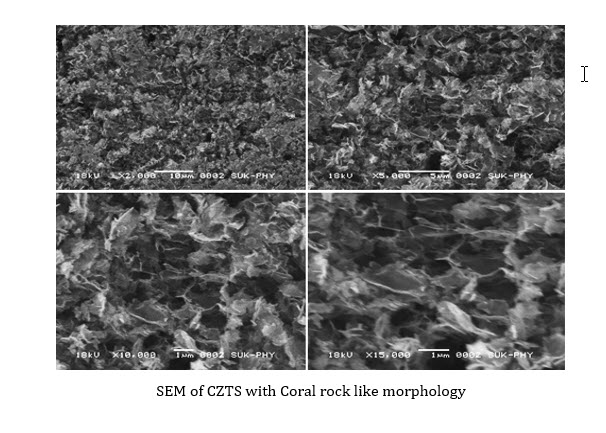Volume 21, Issue 1 (March - Special Issue 2024)
IJMSE 2024, 21(1): 1-7 |
Back to browse issues page
Abstract: (2560 Views)
The Cu2ZnSnS4 (CZTS) thin film is newly emerging semiconductor material in thin film solar cell industry. The CZTS composed of economical, common earth abundant elements. It has advantageous properties like high absorption coefficient and best band gap. Here we have applied low cost chemical bath deposition technique for synthesis of CZTS at low temperature, acidic medium and it’s characterization. The films were characterized by different techaniques like X-Ray diffraction, Raman, SEM, Optical absorbance, electrical conductivity and PEC study. The X-Ray diffraction, Raman scattering techniques utilized for structural study. The XRD revels kasterite phase and nanocrystalline nature of CZTS thin films. These results and its purity confirmed further by advanced Raman spectroscopy with 335 cm-1 major peak. The crystallite size which was found to be 50.19 nm. The optical absorbance study carried by use of UV-Visible spectroscopy analyses its band gap near about 1.5 eV and its direct type of absorption. The electrical conductivity technique gives p-type of conductivity. The scanning electron microscopy (SEM) study finds it’s rock like unique morphology. The EDS technique confirms its elemental composition and it’s fair stoichiometry. The analysis of PEC data revealed power conversion efficiency-PCE to 0.90%.
The Cu2ZnSnS4 (CZTS) thin film is newly emerging semiconductor material in thin film solar cell industry. The CZTS composed of economical, common earth abundant elements. It has advantageous properties like high absorption coefficient and best band gap. Here we have applied low cost chemical bath deposition technique for synthesis of CZTS at low temperature, acidic medium and it’s characterization. The films were characterized by different techaniques like X-Ray diffraction, Raman, SEM, Optical absorbance, electrical conductivity and PEC study. The X-Ray diffraction, Raman scattering techniques utilized for structural study. The XRD revels kasterite phase and nanocrystalline nature of CZTS thin films. These results and its purity confirmed further by advanced Raman spectroscopy with 335 cm-1 major peak. The crystallite size which was found to be 50.19 nm. The optical absorbance study carried by use of UV-Visible spectroscopy analyses its band gap near about 1.5 eV and its direct type of absorption. The electrical conductivity technique gives p-type of conductivity. The scanning electron microscopy (SEM) study finds it’s rock like unique morphology. The EDS technique confirms its elemental composition and it’s fair stoichiometry. The analysis of PEC data revealed power conversion efficiency-PCE to 0.90%.
The Cu2ZnSnS4 (CZTS) thin film is newly emerging semiconductor material in thin film solar cell industry. The CZTS composed of economical, common earth abundant elements. It has advantageous properties like high absorption coefficient and best band gap. Here we have applied low cost chemical bath deposition technique for synthesis of CZTS at low temperature, acidic medium and it’s characterization. The films were characterized by different techaniques like X-Ray diffraction, Raman, SEM, Optical absorbance, electrical conductivity and PEC study. The X-Ray diffraction, Raman scattering techniques utilized for structural study. The XRD revels kasterite phase and nanocrystalline nature of CZTS thin films. These results and its purity confirmed further by advanced Raman spectroscopy with 335 cm-1 major peak. The crystallite size which was found to be 50.19 nm. The optical absorbance study carried by use of UV-Visible spectroscopy analyses its band gap near about 1.5 eV and its direct type of absorption. The electrical conductivity technique gives p-type of conductivity. The scanning electron microscopy (SEM) study finds it’s rock like unique morphology. The EDS technique confirms its elemental composition and it’s fair stoichiometry. The analysis of PEC data revealed power conversion efficiency-PCE to 0.90%.
Type of Study: Research Paper |
Subject:
Composites
| Rights and permissions | |
 |
This work is licensed under a Creative Commons Attribution-NonCommercial 4.0 International License. |




